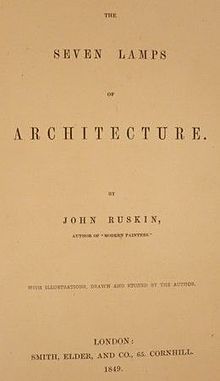 Title page of the first edition | |
| Author | John Ruskin |
|---|---|
| Illustrator | John Ruskin |
| Language | English |
| Subject | Architecture |
| Genre | Non-fiction |
| Publisher | Smith, Elder & Co. |
Publication date | May 1849 |
| Publication place | United Kingdom |
| Media type | |
| Pages | 205 pp. |
| Followed by | The Stones of Venice |

The Seven Lamps of Architecture is an extended essay, first published in May 1849 and written by the English art critic and theorist John Ruskin. The 'lamps' of the title are Ruskin's principles of architecture, which he later enlarged upon in the three-volume The Stones of Venice.[1] To an extent, they codified some of the contemporary thinking behind the Gothic Revival. At the time of its publication, A. W. N. Pugin and others had already advanced the ideas of the Revival and it was well under way in practice. Ruskin offered little new to the debate, but the book helped to capture and summarise the thoughts of the movement. The Seven Lamps also proved a great popular success, and received the approval of the ecclesiologists typified by the Cambridge Camden Society, who criticised in their publication The Ecclesiologist lapses committed by modern architects in ecclesiastical commissions.
- ^ His introduction to the second edition (1855) characterises The Seven Lamps of Architecture not as a "complete exponent" of his matured views but "rather as an introduction to the more considered and careful statements of those views given in The Stones of Venice, and in my Lectures delivered at Edinburgh."